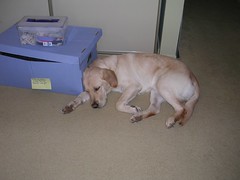
When I had all the colours of thread out, it seemed to me that the dark browns worked. Even when I sewed down the raw edge on the facing, it seemed to be okay. However, when I sewed down the front darts on the shirt, the thread looked too dark. I have now fished some lighter brown - almost beige - thread out of my collection and now I have to decide whether to redo this dart stitching.
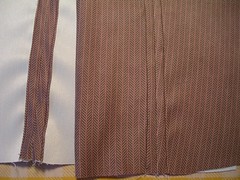
When putting on the spread collar, I sort of follow the instructions but I do my own thing too. First of all, I made the collar by sewing the two pieces right sides together and turning them right side out and pressing them. I had already had the problem of thread colour with the front darts so I didn’t topstitch the collar at this point. I pinned the raw edges of the collar together so it would stay flat as I worked with it.
Next, I pinned the collar on to the shirt all the way across, even though in the centre, in between the two facing pieces, it doesn’t get sewed through all layers to the shirt.
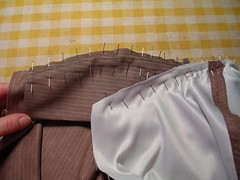
At this point, the instructions say to sew the collar onto the shirt. Instead, I pin the front facings on because I know they’re going to get sewed on to the shirt with the collar and I prefer to do it all at once. What I didn’t know with this fabric is that it moves. It slithers slightly so the edges end up uneven. You’ll see this in one of the subsequent photos.
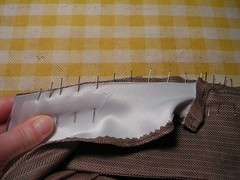
With all the layers pinned heavily together (the facing, two layers of collar and the shirt), I sew them together at the machine. I use so many pins because there is stretching of fabric and bunching of fabric and I don’t want to get any tucks that I will have to pick out later. I took the next picture with my left hand, showing how I work my right hand partly under the fabric as I feed it slowly under the needle. My left hand will be gently pulling the fabric away from the needle as I sew, to make sure it doesn’t bunch up underneath it.
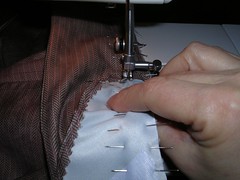
In the next photo, I pulled up the shirt to look underneath it (leaving the needle DOWN in the fabric so it wouldn’t move!), to show how it might bunch up between the pins which is why I’m using both hands to smooth the fabric as I go. You can see the several layers of fabric and what I didn’t notice at this point, which is that the layers are slipping and the edges are no longer even.
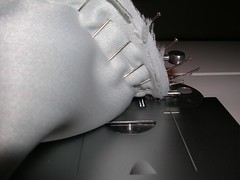
I sewed the facings to the collar and the shirt. I didn’t sew the collar to the shirt in between the facings because only the bottom layer (the underside) of the collar gets sewed by itself to the body of the shirt. The right side (up side) of the collar will get turned under and laid over the stitching line and will be sewed down at the end of this process. Before sewing the middle of the collar to the shirt body, I separate the two layers of the collar and pin only the bottom layer to the shirt.
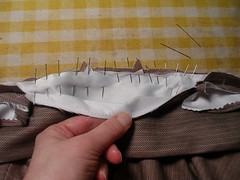
Here, I’ve sewed up to the end of the middle collar part that doesn’t have the facing on it and backstitched a few stitches.
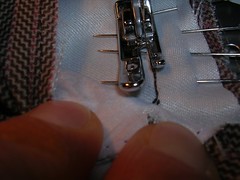
Here is a better view of the line of stitching that doesn’t include the facing. It is the end I started at and I didn’t backstitch so the stitches have started to unravel because I clipped the threads right at the fabric. This won’t matter because of the way I am going to sew down the top layer of the collar.
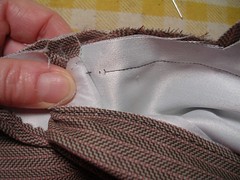
4 comments:
Hi, please see the posting I made requesting information on the interfacings you are using and their sources. I would love to know about them. Thank you and happy stitching.
I use whatever iron-on interfacing they have over at my local fabric store. I really don’t know what brand it is. They have several kinds and I almost always use the light weight knit kind as it seems to move with the fabric better. I bet that there are only one or two manufacturers of the stuff so whatever your store has should work as well as mine does. I think if there’s any trick to it, it’s choosing the right weight (if in doubt go lighter) and making sure you get it solidly attached to the fabric (lots of ironing).
More on the dog at your other comment!
Thanks for explaining Julia. Oh, now I understand about the dog too, although I still have never seen a sight-impaired person shopping with a dog.
I notice you sew over your pins, I know there are different 'schools of thoughts' on this, I am a 'baster' and sometimes pin and baste together but never sew over pins.
Yes, I have sewed over pins for years. I have also broken countless needles in the process. If I don’t break a needle outright, I may put a burr on it for hitting a pin and then it snags the fabric or breaks the thread. So why do I do it? Convenience! I really don’t like basting even though I know it’s good for me. :) I am also somewhat impatient and want a project to be finished soon after I start it. I do remove some pins as I sew so they are gone before I hit them. And I am more careful than I used to be but I still break needles.
Post a Comment